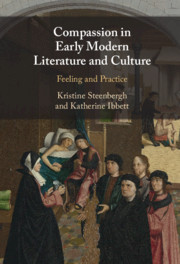Book contents
- Compassion in Early Modern Literature and Culture
- Compassion in Early Modern Literature and Culture
- Copyright page
- Contents
- Acknowledgements
- Contributors
- Introduction
- Part I Theorising
- Part II Consoling
- Part III Exhorting
- Part IV Performing
- Part V Responding
- Part VI Giving
- Part VII Racialising
- Part VIII Contemporary Compassions
- Chapter 15 Contemporary Compassions
- Index
Chapter 15 - Contemporary Compassions
Interrelating in the Anthropocene
from Part VIII - Contemporary Compassions
Published online by Cambridge University Press: 23 April 2021
- Compassion in Early Modern Literature and Culture
- Compassion in Early Modern Literature and Culture
- Copyright page
- Contents
- Acknowledgements
- Contributors
- Introduction
- Part I Theorising
- Part II Consoling
- Part III Exhorting
- Part IV Performing
- Part V Responding
- Part VI Giving
- Part VII Racialising
- Part VIII Contemporary Compassions
- Chapter 15 Contemporary Compassions
- Index
Summary
In this closing chapter, Kristine Steenbergh compares early modern configurations of compassion to contemporary notions of fellow-feeling in multispecies relations. The chapters in Compassion in Early Modern Literature and Culture: Feeling and Practice foreground how the emotion was a situated practice shaped by the religious battles of the Reformation. Like the Reformation, the Anthropocene is a fault line urging a rethinking of ideologies, values, and practices. Humankind’s impact on the earth’s ecosystems shapes a need for new worldviews which are less anthropocentric and more attuned to the interconnections between different life forms on our planet. Steenbergh demonstrates that in the work of Donna Haraway, Deborah Bird Rose and Thom van Dooren, compassion is envisaged as central to posthuman affective relations. In these relations, compassion is inflected similarly to early modern definitions of compassion as a literal ‘suffering-with’.
- Type
- Chapter
- Information
- Compassion in Early Modern Literature and CultureFeeling and Practice, pp. 293 - 301Publisher: Cambridge University PressPrint publication year: 2021
- 1
- Cited by



